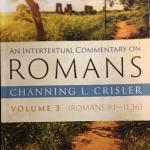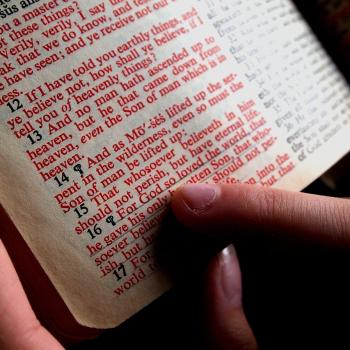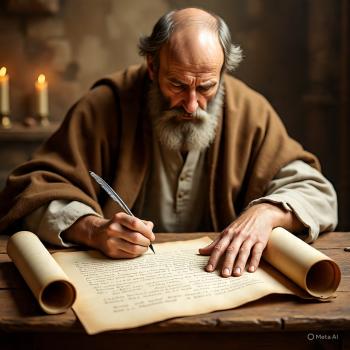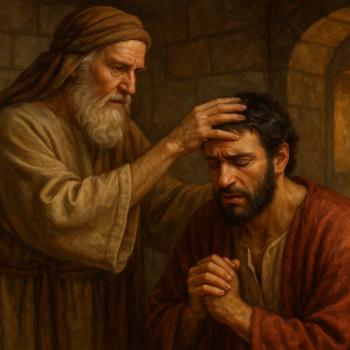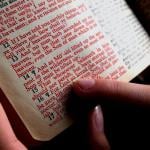Scripture and ancient Jewish literature identify powerful angels as archangels (archangelos/ ἀρχάγγελος). Michael is called an archangel in Jude 9. He contends against Satan. In Revelation 12:7-9 John depicts Michael along with an army of angels fighting against Satan and his angels. In relation to the second coming of Jesus, Paul mentions an archangel’s voice but no name in 1 Thessalonians 4:16.
Daniel 12:1 calls Michael “the great angel” or “chief commander,” a type of guardian angel over Israel (Dan 10:21; 12:1). Although Michael (“who is like God”) is a top-ranked angel in Scripture, Daniel 10:13 states that he is one of the chief princes or commanders (’achad ha-shariym hā-rishniym), perhaps implying other beings who belong to his class.
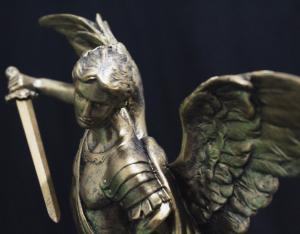
Seven Holy Angels
Some identify the angel Gabriel as another archangel because he has a proper name similar to Michael (Daniel 8:16; 9:21; Luke 1:11-19; 26-38). Another angel of high order is called Raphael, who appears in the Apocrypha text of Tobit 12:15: “I am Raphael, one of the seven holy angels who present the prayers of the holy ones and enter before the glory of the Holy One.”
Interestingly, seven angels stand before God in Revelation 8:2, but text does not give their names. Revelation also mentions seven spirits of God in 1:4 and 4:5. Unless “seven” is purely a symbolic number of completeness in both Revelation and Tobit, these texts may resemble the seven archangels of 1 Enoch 20 (see below).
From Second Temple Jewish literature a case can be made for identifying more top angels beyond Michael, Gabriel, and Raphael.
In the Dead Sea Scrolls’ War Scroll we find Michael, Gabriel, and Raphael together along with a fourth angel named Sariel (1QM 9.15-16). This angel appears also in 1 Enoch 20 among the seven archangels.
In the Sibylline Oracles 2.215 we find the same four angels together, but Uriel has replaced Sariel. The same is true for rabbinic literature such as Numbers Rabba 2:10 and Pesiqta Rabbati 44 (see G. W. E. Nickelsburg’s commentary, 1 Enoch 1-36; 81-108, Hermeneia; Fortress, 2001: 207, 294). The Book of Parables likewise has four (see below).
Angels in the Book of Watchers: 1 Enoch 9-10
Michael, Gabriel, and Surafel (Uriel) observe from heaven the oppression and bloodshed on earth due to the sins of the Watchers and their offspring the giants. They call on God to intervene and bring judgment. God does so by stating he will flood the earth (cf. Genesis 6–9).
The angels are then assigned a role to perform: Asuryal (Istrael, possibly Uriel) is to reveal to Noah, “the son of Lamech” the coming flood on earth so that Noah can escape it and preserve his posterity. Raphael is to bind Azaz’el, one of the chief Watchers, who taught humans to make such things as swords, shields, jewelry, and ornamentation. He is to be cast into a pit in the desert to await a fiery final judgment. Gabriel is to destroy the children of adultery and the giants, getting the giants to fight against one another. Michael is to announce to Semyaz and the other Watchers that they will die along with the women with whom they committed fornication.
Surafel/Uriel and Asuryal (if a different angel and not a corrupt text) seem to be the same class of angels as Michael, Gabriel, and Raphael.
The Seven Archangels in the Book of Watchers: 1 Enoch 20
The Ethiopian Enoch 20:1–7 has six holy angels: “And these are names of the holy angels who watch: 2 Suruʾel [Uriel in the Greek version], one of the holy angels—for (he is) of eternity and of trembling [Tartarus].3 Raphael, one of the holy angels, for (he is) of the spirits of man. 4 Raguel [Reuel] one of the holy angels who take vengeance for the world and for the luminaries. 5 Michael, one of the holy angels, for (he is) obedient in his benevolence over the people and the nations. 6 Saraqaʾel [Sariel], one of the holy angels who are (set) over the spirits of mankind who sin in the spirit. 7 Gabriel, one of the holy angels who oversee the garden of Eden, and the serpents, and the cherubim” (E. Isaac in Old Testament Pseudepigrapha [OTP], J. H. Charlesworth, ed.). The Greek version of 1 Enoch adds Remiel to this list and states that the seven are “archangels.”
This seems to be where the tradition of seven archangels originates. In other places of ancient Jewish literature at least five of these angels are likewise identified as archangels:
- Uriel: Testament of Solomon 2.4 (Ouriel); also see 1 Enoch 79.6
- Raphael: Greek Apocalypse of Ezra 1:4 (“archstrategos”)
- Michael: 2 Enoch 22.1; Testament of Abraham [A] 10.1; Apocalypse of Sedrach 14.1; etc.
- Gabriel: 2 Enoch 21.3
- Remiel: 4 Ezra 4:35-37 (Jeremiel); perhaps Apocalypse of Zephaniah 6.15 (Eremiel “great angel”)
Apart from the names in 1 Enoch 20, ancient Jewish literature mentions at least several other archangels by name: Dokiel and Purouel (Testament of Abraham [A]: 13.10-11); Azael (Testament of Solomon 7.7-8); and Vrevoil (2 Enoch 22.10). Hence, the number of archangels does not appear to be limited to seven given the entire scope of Second Temple literature.
Top Angels in the Parables of Enoch (1 Enoch 37–71)
In the Parables of Enoch Phanuel joins the list of prominent angels. There are “four faces” who declare praises before the Lord of glory. The first is identified as “the merciful and forbearing Michael; the second one, who is set over all disease and every wound of the children of the people, is Raphael; the third, who is set over all exercise of strength, is Gabriel; and the fourth, who is set over all actions of repentance unto the hope of those who would inherit eternal life, is Phanuel by name” (1 En. 40.9 [OTP]).
As one of the four top angels, Phanuel here and in 1 Enoch 54.6 and 71:8-9, 13 seems to have replaced Surafel/Uriel from 1 Enoch 9-10. We see resemblances to the four faces in Ezekiel 1 and Revelation 4. Interestingly, in the heavenly ascent of Enoch, amidst seeing countless angels and seraphim, cherubim, ophanim, and “sleepless ones” that surround the thorn, he sees Michael, Raphael, Gabriel, and Phanuel, “and numerous (other) holy angels” (1 En. 71.8). This perhaps suggests many more than four or seven top angels!
These traditions seem to have influenced Jude and later Christian authors regarding archangels, though Michael is the only one explicitly mentioned with this title in the New Testament.




